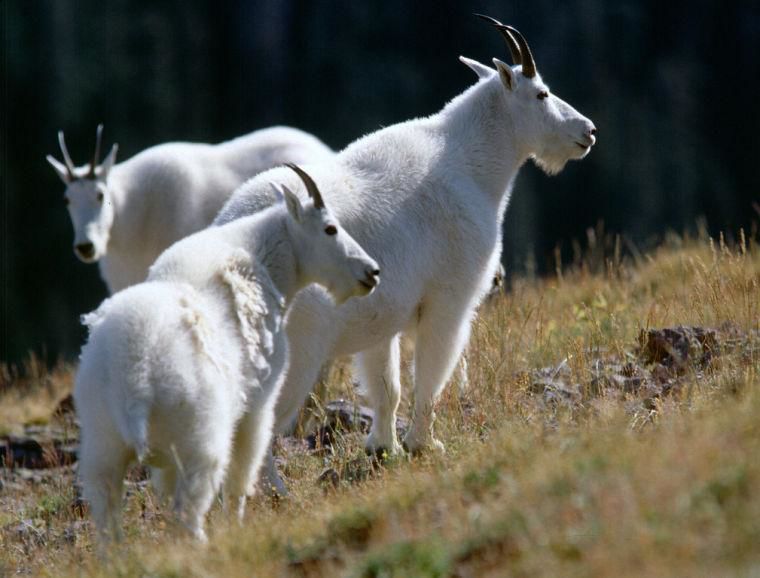Mountain goats may be one of the most iconic species in high mountain ranges, but that doesn’t necessarily mean they belong on every mountain.
On Wednesday, Sept. 18, from 7 to 9 p.m., the Grand Canyon Trust will give a presentation at the Moab Arts and Recreation Center (MARC), 111 E. 100 North, on non-native mountain goats in the Manti-La Sal National Forest and the research that the organization has documented in the area over the past four years.
The Grand Canyon Trust is a nonprofit organization dedicated to Colorado Plateau conservation and environmental advocacy.
The talk, titled “Mountain Goats: Wallowing in Alpine Meadows,” will make the case for why these non-native species are “wreaking havoc on the La Sal Mountains’ alpine plant community,” according to the event flyer.
Mary O’Brien, the Utah forests program director for Grand Canyon Trust, said the purpose of the talk is to report on how the Grand Canyon Trust has been documenting increasing damage over the years as the herd grows and an update on what the Trust is doing to challenge this in court.
O’Brien said the Utah Division of Wildlife Resources originally helicoptered in 35 goats and now there are more than 140, with plans to allow the herd to increase to 200.
“We’re documenting the damage, and likely at some point we’ll be back in court,” she said.
Featured speakers include O’Brien and Grand Canyon Trust staff attorney Aaron Paul.
This will be the second presentation by Grand Canyon Trust on non-native species.
On Aug. 22, Jerry Shue, Grand County’s bee inspector, gave a presentation at the MARC on the risks of introducing non-native honey bees, particularly the European honey bee (Apis mellifera).
The nation’s largest commercial honey bee operator, Adee Honey Farms, recently submitted an application for a 10-year special-use permit. The permit would allow the business to keep a large number of hives on Utah’s national forests four months out of the year, including the Manti-La Sal National Forest.
Shue has over 40 years of bee experience and discussed how “honey bees are under tough times.”
Even though the European honey bee is hardy and adaptable, many honey bees are under extreme pressure from outside influences, such as “parasites, pathogens, pesticides, loss of forage and poor nutrition,” he said.
For this reason, many commercial honey operators seek to move their hives for several months, when the bees are through pollinating almonds or apples in California or Washington.
However, Shue said that honey bees will not go extinct because they are “managed,” explaining how “economics, ecology, politics and even philosophy” all play a role in the issue of promoting non-native honey bees versus native bees.
“European honey bees have been here in the United States for 400 years. It is hard to see them as invasive,” Shue said.
Vince Tepedino, a retired bee biologist said, “Beekeepers need to relocate their hives to areas where their bees can collect both nectar and pollen to produce honey for sale and to build up stores to support the hive for the winter and early the following spring.”
This presents two main problems for native bees: competition for resources and potential disease transmission.
O’Brien discussed the negative impact that introducing the non-native honey bee may have on the natural ecosystem.
“It is important we recognize the value of native bees,” O’Brien said, warning that the impact on native bee species could be irreversible.
“The public should be concerned about this emerging issue. We don’t know how long the consequences may be,” said O’Brien.
The requested permit for placing honey bees in the Manti-La Sal National Forest falls under a categorical exclusion requiring no public comment period.
O’Brien said these industrial scale honey bee operators are “using public lands for free real estate, free pollen, and free nectar.”
In 2015, Grand County became the first county in the nation to adopt ordinances providing protection to the local bee population, specifically preventing migratory commercial bee keepers from bringing their hives into the county.
Over 30 citizens attended the presentation.
“I wanted to learn about the role native and non-native species play on our public lands,” said Moab local Sam Hodges.
Utah is third in the nation for diversity of native bees. The state is home to over 1,000 species.
For more information, contact Mary O’Brien at maryobrien10@gmail.com or 541-556-8801.
What: Mountain Goats: Wallowing in Alpine Meadows
When: Wednesday, Sept. 18, from 7-9 p.m.
Where: Moab Arts and Recreation Center, 111 E 100 North
Cost: Free
For more information, contact Mary O’Brien at maryobrien10@gmail.com or 541-556-8801.




